The Road to 9,000 Follicular Units!
If I had never undergone a hair transplant, I would already be at Stage 6 — meaning I would have no hair left, except in the donor area. My first hair transplant took place in 2006, but my story began several years earlier!
I’d like to share my journey for two main reasons:
- To show how I, too, once fell “victim” to the many myths surrounding FUE Hair Transplantation — myths that are still circulating today. And I will explain, in full detail and with complete accountability, why, based on my knowledge as both a surgeon and a patient, I should have made better choices when selecting clinics — both for my first and second procedures.
- Because the overwhelming majority of “clinics” performing FUE hair transplantation continue to repeat the same mistakes that have been happening since the technique first appeared in 2004. In the past, these errors were due to the immaturity of the FUE method. Today, however, they persist due to a lack of professionalism:
- Excessive numbers of grafts harvested in a single session, leading to irreversible donor area damage, with only a small percentage of grafts ultimately surviving
- Reckless attempts to extract unnecessarily large numbers of grafts in one day
- Overly dense harvesting, resulting in permanent thinning and depletion of the donor area
- Use of overly large extraction punches to speed up the process, causing severe collateral damage and visible scarring
- Incorrect punch insertion angles, which cause deep tissue trauma and unsightly scarring.
All of the above lead to the same result: excessive trauma to the donor area, widespread scarring, and poor graft survival rates!
At my clinic, we have now FULLY resolved all those problems that once seemed insurmountable.
- We have achieved a consistent graft survival rate of 95–98% with the FUE technique. Unfortunately, this is not the case in most other clinics, as they fail to implement the necessary protocols to support and protect grafts — which are naturally more vulnerable with FUE
- I implement a digitally planned extraction strategy, covering the entire Safe Donor Zone (SDZ), ensuring even distribution so that patients can cut their hair as short as they like — with no visible signs of thinning or scarring
- I use extraction punches measuring just 0.7–0.9 mm, and I always insert them at a 90° angle to minimize trauma
- The postoperative period is always smooth, with no lingering discomfort, redness, or sensitivity whatsoever!
Today, at Anastasakis Hair Clinic, even with over 8,000 FUs removed across three FUE transplant sessions, patients can confidently wear their hair short — with no visible marks, no thinning, and no discomfort. Most importantly, they enjoy near-100% graft survival, natural density, and a full, vibrant head of hair — no matter how “empty” it once was!
A Bit of My History
Unfortunately, I started losing my hair at an early age.
As I was (and still am) affected by Androgenetic Alopecia, I decided at the age of 20 to address it as effectively as possible. From that age onward, I have been using 5% topical Minoxidil foam continuously, and at age 31, I added 1mg oral Finasteride to my treatment regimen.
To this day, I continue both treatments without interruption.
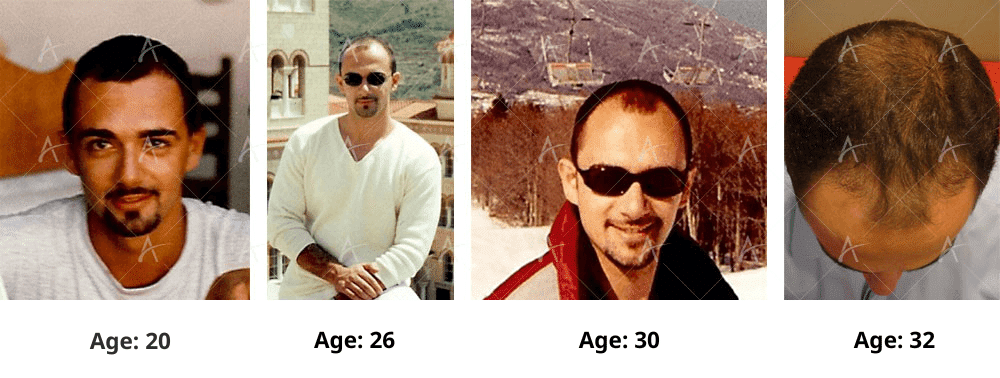
In the first photo, I’m 20 years old, and some hair loss had already begun around my temples. I decided to start treatment with 5% Minoxidil foam, and the response was excellent for the five years I used it daily!
Unfortunately, due to poor advice from a non-specialist doctor who told me to stop the Minoxidil and try a treatment of his own invention, I discontinued Minoxidil at age 25. By age 26, it’s easy to see how much hair loss I had experienced. (Lesson one: you can only rely on ethical, specialized doctors!)
Fortunately, I resumed the 5% Minoxidil foam treatment after a few months, but some of the lost hair never regrew, as seen in the photo at age 30.
The condition gradually worsened, so I added 1mg Finasteride to my regimen. Hair loss stabilized somewhat, and some new hair grew back, but I was still not satisfied with the overall appearance. Therefore, I decided to undergo a hair transplant. In 2006, I chose to have a hair transplant because the frontal area (hairline and temples) was significantly depleted — and medication could no longer help in those zones.
The good news was that my donor area had excellent characteristics: a density of 90 FUs/cm² (average is 70 FUs/cm2), an average of 2.6 hairs per follicular unit (average is 2.2 hairs/FU), thick hairs with a diameter of 60 microns (average 50 microns), and naturally wavy hair.
Technical Details Before I Continue
As a patient, I underwent three FUE hair transplant sessions between 2006 and 2013. The first session was a “test” procedure, involving only 200 grafts using the FUE technique. The following two sessions were full-scale FUE hair transplant surgeries. The first two procedures were performed by the same surgeon, while the third was carried out by a different surgeon.
My First FUE Hair Transplant in 2006
I chose to undergo an FUE hair transplant because, at the time, it was the most advanced technique available and promised no visible scars or marks in the donor area!
I knew the FUE technique was associated with a milder postoperative period and would allow me to cut my hair in any style I wanted in the future—even almost shaved in the donor area. These were the main reasons I opted for FUE over FUT (Follicular Unit Transplantation).
Overall, I underwent three procedures performed by two different surgeons, both pioneers in FUE hair transplantation at that time. It’s important to remember that FUE was still experimental when it first appeared at the end of 2002, and was cautiously introduced from 2004 onward.
In hindsight, my choice to undergo FUE in its early days wasn’t the best fit for me.
While FUE is an excellent technique, it is:
- Suitable only for specific cases and patient categories (which I certainly belonged to)
- Effective only under certain conditions (unfortunately, as we will see, these conditions were not met — and even today, few clinics adhere to them, with Anastasakis Hair Clinic being a notable exception)
What I Thought I Knew Before Undergoing FUE Hair Transplantation
As a Head and Neck Surgeon, I took my first steps into the FUE hair transplant technique at the end of 2004. At that time, we knew very little about this new hair transplant method, and the territory was still largely uncharted. Unfortunately, I was one of the “victims” of the unknown factors surrounding the technique back then!
For an experienced, specialized, and ethical surgeon, the FUE hair transplant technique is a very useful “tool” that allows helping more patients—especially those who previously would have been considered unsuitable candidates for hair transplantation using older, established methods.
As a surgeon, I have managed to help patients who would have otherwise been impossible to treat effectively without FUE.
When I decided to undergo an FUE hair transplant myself (in 2006), my experience as a surgeon with the technique was sufficient to believe that I would achieve satisfactory results as a patient:
- I knew that FUE had the disadvantage of lower graft survival compared to the “mature” FUT technique. (Note: Today, in experienced hands—especially at Anastasakis Hair Clinic—this is no longer the case!) This fact did not worry me because, with thick, multi-hair follicular units like mine and favorable hair characteristics (wavy hair), I assumed that the inevitable loss in graft survival wouldn’t cause a noticeable problem.
- I also believed that because there would be no incision or stitches in the donor area, I would avoid discomfort, pain, and numbness.
- The impression that FUE is accompanied by a “milder” postoperative period was the main reason I chose a large FUE session (Megasession) instead of FUT for my second procedure in 2012.
- Equally important was my belief that I could cut my hair as short as I wanted in the future!
As I mentioned earlier, with the knowledge I have now as both surgeon and patient, I realize that in every case, I should have undergone an FUT hair transplant in 2013, rather than the FUE technique as it was practiced between 2008 and 2013.
Why I Should Not Have Chosen the Megasession FUE in 2013
Because of my choice, I ended up with:
- Fewer hairs growing in the recipient area compared to the FUT technique
- A large number of prominent micro-scars in the donor area, which forces me to keep my hair longer and, of course, prevents me from cutting it as short as I would like
- Permanent redness (erythema) in the donor area, which also forces me to keep my hair longer
- Diffuse thinning in the donor area, giving it a “moth-eaten” appearance when the hair is cut short
- Several months of discomfort in the donor area following the Megasession procedure.
I want to emphasize that none of these significant problems occur with the modern techniques we apply at Anastasakis Hair Clinic today. However, back then, these issues were common. Unfortunately, even in the present day (2024+), many clinics still use outdated donor area management protocols and tools for FUE in order to keep costs low and shorten procedure times—without regard for the permanent negative consequences this has for the patient.
My Story Undergoing FUE Hair Transplantation
As a Hair Restoration Surgeon myself, and driven by a strong scientific curiosity, we decided to apply some ideas on me that were quite innovative at the time:
March 2006: I underwent an “unshaven session” with just 200 follicular units (FUs), trimming only 3 strips from the donor area (Fig. 1a-c). This was a novel concept in 2006, promising no need to shave the donor area, so no one would notice that an FUE hair transplant was performed. The goal was to confirm satisfactory follicle survival, as at the time FUE survival rates were around 75-80%, regardless of surgeon skill. We transplanted the grafts to the temples to slightly close them. At 12 months post-op, 152 of 200 follicles had grown (75% survival).
October 2008: A session of 1,200 FUs (Fig. 2a-f). After confirming about 75% follicle growth at the temples, I waited 18 months before restoring the hairline and remaining temples. This session again showed good follicle survival.
March 2013: A Megasession FUE procedure (2,500 FUs) (Figs. 3-5). As hair loss progressed despite ongoing dual medication therapy, I decided to cover both front and back balding areas and densify the temples and hairline from the previous session. The Megasession FUE was also an innovative concept in 2013, and since my donor area was excellent with easy graft removal, we extracted 2,500 grafts in just 3 hours using the Power Sharp Punch technique. However, many errors occurred:
- The rapid extraction caused significant trauma to both removed and surrounding follicles
- A larger punch tool was used to speed up the process, instead of smaller, more precise tools
- All grafts were harvested from the easiest posterior part of the scalp (occipital area), rather than evenly distributed across the donor zone, resulting in excessively sparse areas compared to the sides.
Fortunately, at Anastasakis Hair Clinic, Megasession FUE has now evolved into a powerful tool. We perform detailed measurements of each sub-area of the donor zone, use specialized software to calculate the exact number and types of follicles to harvest, and set maximum daily follicle extraction limits.
Still, back in 2013, a high success rate for a Megasession FUE procedure was unlikely.
What Were the Results of My FUE Hair Transplant Up to 2015?
Let me take you through my personal journey as an FUE hair transplant patient from 2006 to 2015.



The so-called “no-shave session” (which I underwent in 2006), where the surgeon only trims narrow strips in the donor area—covered by the surrounding hair—and extracts follicles from those strips, results in highly unaesthetic scarring. The surgeon is forced to extract follicles very close to one another, causing the micro-scars to inevitably “merge,” creating an unsightly result—worse even than a typical FUT scar. The arrows highlight the long, narrow scars I developed after the removal of just 200 follicles. Imagine the outcome if someone attempted to extract 1,000 follicles using this “no-shave session” technique!
Unfortunately, many clinics still perform this technique today—and even market it as ‘innovative’!

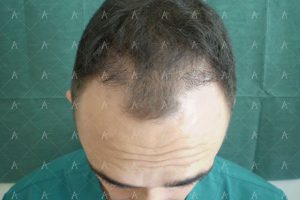




Photos a–c show approximately 160 of the 200 grafts from the previous “no-shave” session that have grown and matured in the temple areas (arrow), along with the hairline design for the second session.
Photos d and e show the newly implanted grafts immediately after transplantation, while photo f shows the donor area after the extraction of 1,200 grafts.
The linear scars from the “no-shave” session are still visible in Fig. 2f.



The grafts from the second session (1,200 FUs) grew satisfactorily. However, over the years (2008–2013), I experienced additional hair loss in areas behind the hairline and at the crown.
As a result, I proceeded with another FUE hair transplant session. These photos were taken just before trimming the donor area.




Once the donor area was trimmed, the signs of the second FUE hair transplant session also became visible—amounting to a total of approximately 1,400 white dot scars. This confirmed that the supposed advantage of being able to wear a very short haircut after FUE is a myth, unless the follicle extraction is performed strategically and evenly distributed. Personally, I would never cut my hair that short again, knowing these scars would be visible. Of course, with slightly longer hair—around 3–4mm—nothing would be noticeable. But the option of a true “shaved look” was no longer viable.
Note 1: In my case, the high density of the donor area and the strong contrast between dark hair and fair skin made the scars much more visible. At Anastasakis Hair Clinic, in similar cases, micro-scars are distributed across a much wider area, so even a shaved look remains undetectable.
Note 2: The use of finer instruments—standard at Anastasakis Hair Clinic—also plays a major role, as they cause significantly less trauma to the skin!

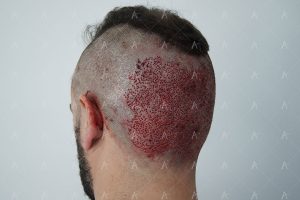
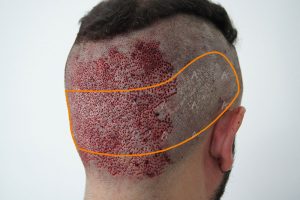

Notice that in order to harvest these 2,500 grafts, the surgeon unfortunately expanded the extraction area vertically—both upward and downward—at the center of the donor zone, rather than moving forward along the orange-marked area. While this approach may have made extraction technically easier, it was a mistake.
The result was excessive trauma to the donor region and visible scarring, with grafts taken too close together. Even today, the signs remain noticeable due to this poorly planned harvesting pattern.

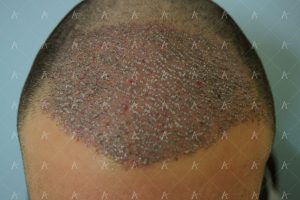


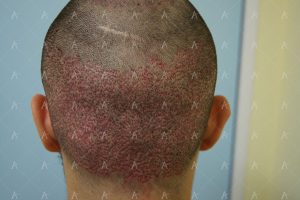
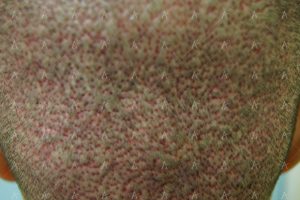
There is significant discomfort across the entire donor area, which is expected at this stage. The recipient area feels numb. The 3,000 micro-incisions have begun to heal and gradually shrink in size, which creates a strong, diffuse sensation of tightness and tension.






By day 7, the hair has grown approximately 2–3mm. However, the donor area remains highly irritated, red, and painful—even to the lightest touch. There is also a constant feeling of tightness, caused by the healing of the 3,000 micro-extraction sites.
At this stage, I began to feel concerned. I knew from experience that my own patients who had undergone a FUT hair transplant typically report no discomfort at all in the donor area by day 4 or 5.
This prolonged discomfort in my case was due to several factors:
- An excessively high number of incisions were made in a relatively small area. Critically, the extraction was not evenly distributed across the entire donor zone. For the sake of speed and convenience, the harvesting was concentrated mainly in the occipital area
- The punch tool used was relatively large—1.2 mm in diameter
- The angle of punch insertion was not perpendicular, which can increase tissue trauma by 30–50%





Twelve days after the procedure, the irritation has not subsided. The donor area remains highly inflamed, red, and consistently painful. The transplanted hairs in the recipient area have not yet shed.
At this point, I began to realize that we had likely extracted too many grafts using the FUE technique. The overall trauma to the scalp was simply too extensive, which explains the prolonged discomfort and slow recovery.





By day 30, all the hairs from the transplanted grafts have shed, as expected. Unfortunately, the donor area remains irritated. Despite the excellent baseline characteristics of my donor zone, it now appears visibly thinned.
In the photos, my hair is trimmed to 9mm in length—and it’s already clear that longer hair is necessary to conceal both the irritation and the thinning in the donor area.







The donor area remains irritated. Irreparable damage has been caused by the excessive trauma sustained during graft extraction, and it is now evident that with hair length at 9mm, the area appears thin and patchy. Going forward, I will need to keep my hair longer to better conceal these imperfections.
I am now convinced that choosing a megasession FUE hair transplant—extracting such a high number of grafts in a single session (2,500) and overall (4,000)—likely results in permanent damage to the donor area, at least when performed using the FUE technique as it was applied in 2013.



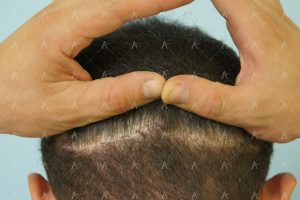

At this point, all the transplanted grafts that were going to grow have fully developed. The donor area appears satisfactory only when the hair is grown out to about 15mm (1.5 cm), but not with shorter hair. However, if I lift the hair, the micro-scars and thinning become visible. The redness has now become permanent!
What I Learned from My Experience as an FUE Hair Transplant Patient Until 2015
Let’s take a closer look at the reality I experienced as a patient undergoing three FUE hair transplant procedures between 2006 and 2013:
- The “Unshaved Session”: The so-called “unshaved session” results in highly visible scarring. The surgeon is forced to extract grafts very close to each other, causing the micro-scars to inevitably merge and create a very unattractive appearance—worse even than a FUT scar. (Fig. 1a–c)
- Short Haircut: One of the main “advantages” of FUE hair transplantation—the ability to have a very short, nearly shaved haircut—does not hold true unless the graft extraction is performed strategically. Each extraction point leaves behind a small, round, white scar, known internationally as “white dots,” which are visible in every FUE transplant case. (Fig. 1a–c, Fig. 4a–d)
- Scarring and Thinning: If an excessive number of grafts are extracted overall from the donor area during a patient’s lifetime using FUE—no matter how dense or gifted the donor hair is—the donor zone risks becoming visibly thin.
(Note: With the modern donor area management techniques at Anastasakis Hair Clinic, using 0.7–0.9mm punch tools and always maintaining a perpendicular angle of insertion, these issues are now effectively resolved! As a surgeon, I have extracted as many as 8,000 follicular units in 3 sessions on the same patient, with the donor area still looking excellent.)
- Pain and Discomfort: While the healing process after my second FUE session (1,200 grafts) was very well tolerated with minimal discomfort, I experienced significant pain and difficulty for at least 2 months following the megasession FUE (2,500 grafts). The pain during contact with the donor area (whether touching with the hand or lying on a pillow) persisted for an additional 3 months. (Fig. 5a–d)
Note: Thanks to the advanced donor management techniques used at Anastasakis Hair Clinic—employing smaller punch sizes (0.7–0.9mm) and perpendicular entry angles—none of these complications occur anymore!
What Would I Change If I Could Turn Back Time?
Despite the excellent characteristics of my donor area, the final result is not as dense as it should be after a total of 3,900 grafts transplanted over three FUE sessions. (Fig. 11a–e)
If I could turn back time:
- First and foremost, I would never have undergone the “unshaved” session
- I would have chosen a different surgeon for the megasession FUE—one who would have expanded the graft extraction over the entire donor area, used a smaller punch tool, and caused less trauma to the donor zone
- I might have opted for two smaller FUE sessions (up to 1,500 grafts each) instead of a single 2,500-graft megasession, which caused me severe discomfort for months, along with permanent redness and scarring in the donor area. Back in 2013, megasession FUE techniques had not yet reached the level of refinement they have today
- I would have selected a surgeon who could guarantee a higher graft survival rate.
Unfortunately, time cannot be turned back.
What Happened in the End?
When life gives you “lemons,” make the best lemonade — as the saying goes.
That’s exactly what I did!
I took the hard lessons learned from my personal experience and used them to perfect the technique I now offer to my patients.
What We Have Achieved at Anastasakis Hair Clinic in FUE Hair Transplantation
At Anastasakis Hair Clinic, we have resolved all the issues that made my earlier choices less than ideal. Today, we reliably and consistently know:
- How to achieve nearly 100% graft survival rates
- How to manage the donor area in a way that allows any hairstyle in the future without scars, visible marks, or thinning patches
- Which tools to use to minimize damage during extraction
- The optimal number of grafts to transplant per day to ensure the procedure is as minimally traumatic as possible.
Currently, at Anastasakis Hair Clinic, I primarily perform FUE hair transplantation using titanium manual punches or mechanical MAMBA punches (Trivellini “flared” and “edge-out”), complemented or alternatively using blunt punches (Harris S.A.F.ETM hexagonal punch).
The Issue of Scarring in FUE Hair Transplantation
Despite many years of use, FUE hair transplantation is still often marketed by many as a “new technique” and “scarless.” This is not true. The only official international scientific organizations, ISHRS and ABHRS (American Board of Hair Restoration Surgery), strictly prohibit their physician members from using terms such as “painless,” “scarless procedure,” “no incision,” “no touch,” “no cutting,” and “minimally invasive procedure.
In an official statement, ISHRS confirms that FUE hair transplantation is a scar-spreading technique and even explains how to calculate the length and surface area of scars resulting from FUE compared to FUT hair transplantation.
How Much Scarring Are We Really Talking About?
The length and surface area of scarring in the FUE technique are indeed significantly greater than those in the FUT technique. However, when grafts are harvested strategically and according to the original density of each donor area, the micro-scars literally disappear among the existing hair—even at very short hair lengths! This is the true magic of FUE.
Comparison: How Much Scarring Does the FUT Technique Actually Cause?
Below are photos from cases I personally operated on at Anastasakis Hair Clinic. All these scars are thinner than 0.5–1 mm (millimeter) and after a few months will be approximately 50% thinner due to natural healing, matching the skin tone.
However, you no longer need to be concerned about the FUT technique!At Anastasakis Hair Clinic, I now use FUT very rarely, only in cases where it is truly impossible to harvest additional grafts using the FUE technique. And I can personally guarantee that if I manage your first hair transplant surgery, this will never happen to you!
The best example is myself: I underwent two more surgeries (2021, 2022) using the FUE technique, where an additional 5,500 grafts were extracted from my already heavily treated donor area. Even now, my donor area looks great, and I can wear any haircut I want! We achieved this by homogenizing the donor area through highly complex and precise measurements combined with absolutely targeted follicular unit extraction.
The Unpleasant Surprise
Despite continuing medical treatment against hair loss, fate had an unpleasant surprise in store for me: over the years, I kept losing hair in the recipient area, until only the transplanted follicles remained throughout the entire region.



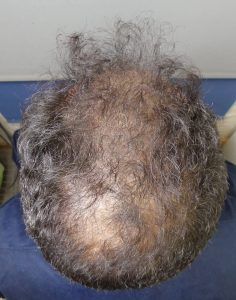

Since I was no longer satisfied with my appearance after the previous transplants (Fig. 12a-e), I decided to undergo an additional hair implantation to address the needs that had arisen during the decade from 2012 to 2021, following my earlier, less successful transplant. The entire nursing team at Anastasakis Hair Clinic participated in this procedure.
However, with the targeted strategy I now apply to my patients, combined with highly precise measurements and the use of advanced technology, we were able to implement a perfect scientific approach and procedure!
PRECISION MEASUREMENTS in Hair Transplantation



The donor area was shaved (Fig. 13a-c) in order to perform precise measurements using specialized software, which allows us to determine how many and which follicular units can safely be extracted from the donor region.





Accurate measurements were taken for hair density in each region, hair thickness, surface area, average number of hairs per cm2, and other parameters. Areas with excessive thinning from previous procedures were excluded (marked with an X). (Fig. 14)






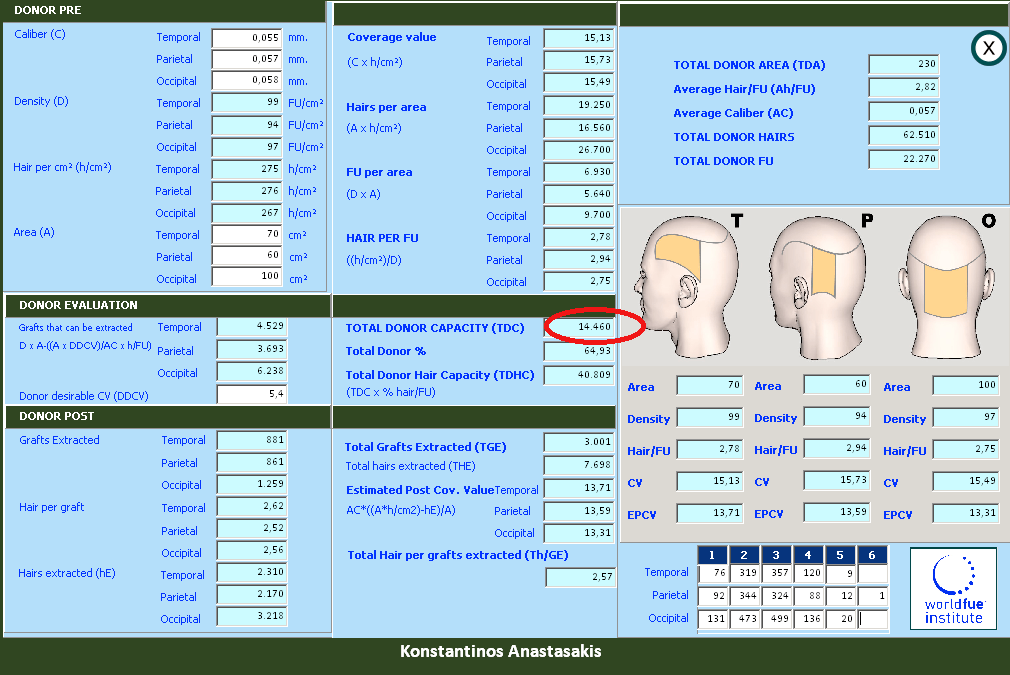
The pleasant surprise was that, according to the specialized software, the donor area could still “offer” almost 15,000 follicular units without appearing thin. (Fig. 15a-g)
Since it was proven that there was still an “abundance” of follicular units, I decided to fully restore the area in two stages:
- In the 1st stage (megasession of 3,000 follicular units), I would lower the hairline height, which I now considered too high (a very large forehead), and densify the frontal area. (Fig. 16)
- In the 2nd stage (megasession of 2,500 follicular units), I would densify the posterior area.
1st stage megasession FUE – 3,000 follicular units, November 2021:
In this procedure, follicular units were extracted from the entire donor area. Special emphasis was placed on the temporal and parietal regions to ensure that the final appearance of the donor area, once the hair grows out, would be uniform and natural-looking. (Fig. 16a-c)
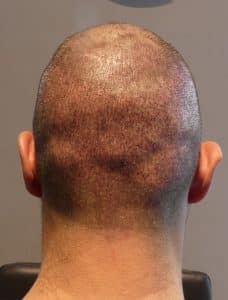

In the recipient area, the hairline was redesigned and lowered, with increased density extending up to the midscalp. We precisely recorded how many follicular units were harvested from each donor region, the number of hairs contained in each graft, the exact placement of each graft within the recipient subregions, and their characteristics. (Fig. 16d)




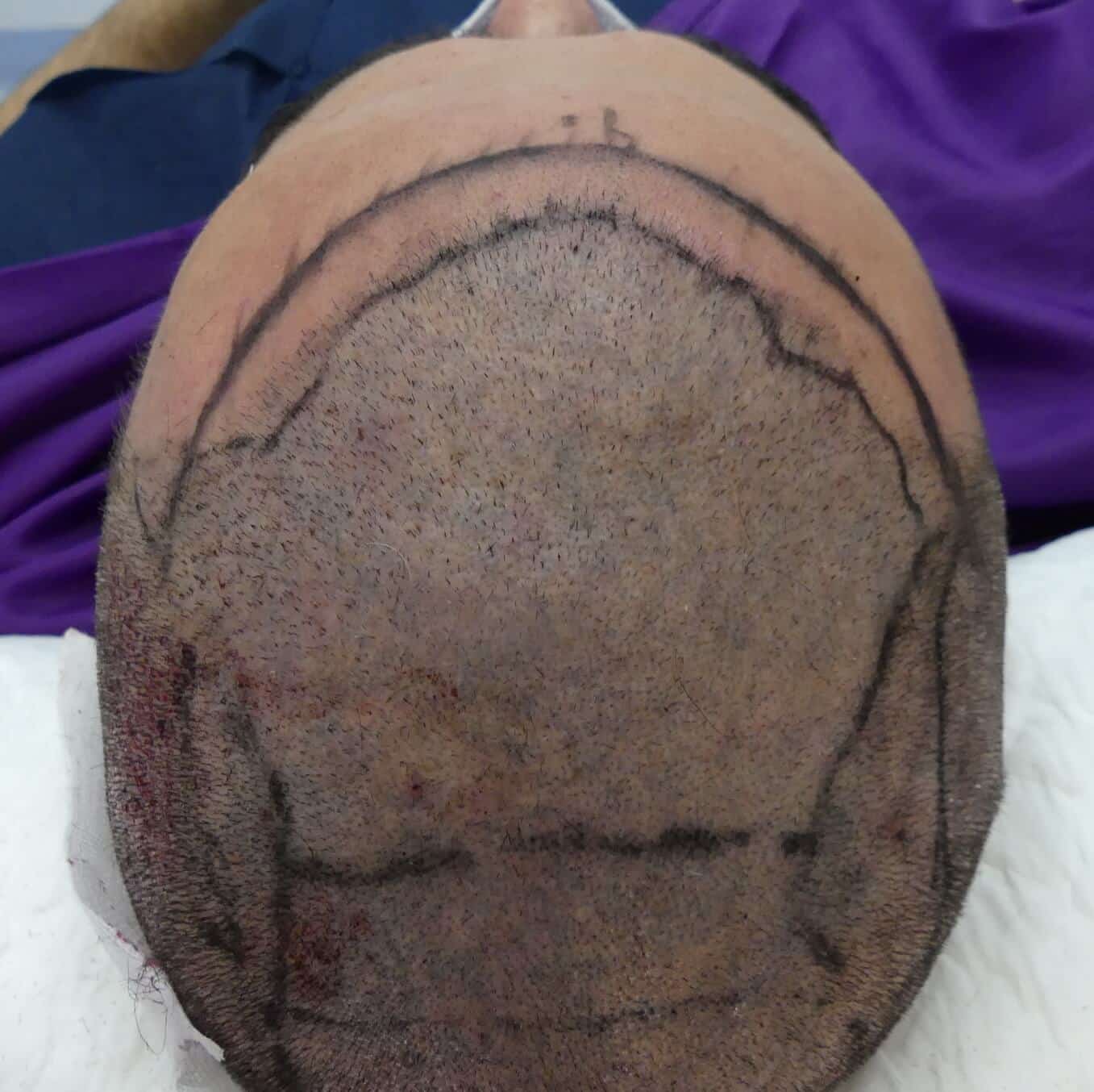
What was different about this modern megasession FUE procedure?
Literally EVERYTHING!- Exceptionally precise measurements of the donor area were taken before follicle harvesting
- Meticulous recording and measurement of grafts were done, categorizing them by containing 1, 2, 3, 4, or even 5 hairs, so we could strategically place each follicular unit for maximum aesthetic outcome
- Harvesting was performed with precision, not “by eye,” to ensure a uniformly natural appearance overall
- A microscopic 0.8mm punch was used, causing minimal trauma
- The procedure was carried out over two days to minimize both local trauma and graft handling stress.
How were the following days?
Surprisingly pleasant and mild! My procedure took place on Friday and Saturday, and by Monday morning I was already at the clinic working, with minimal swelling and absolutely no pain. The donor area had already healed by the 4th day (Fig. 17a-d), and by day 9, there was literally no visible sign at all! (Fig. 18a-e).


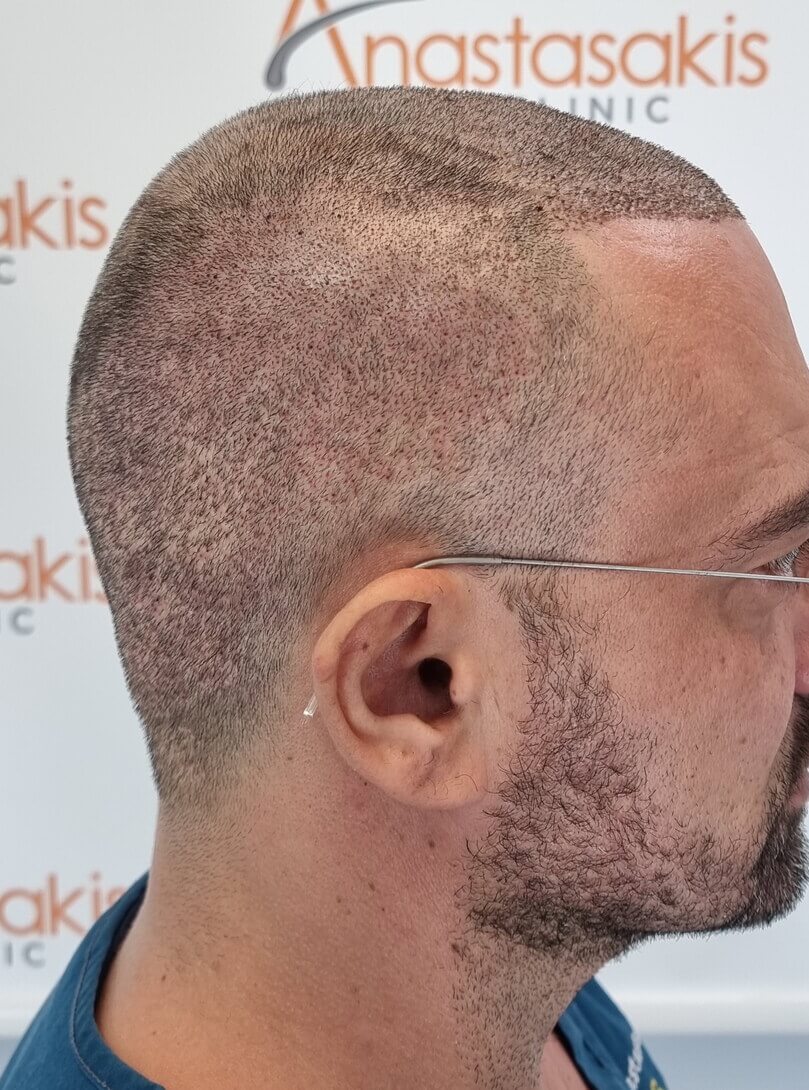


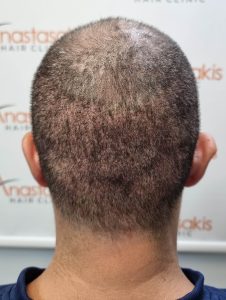


But perhaps the most remarkable part is that, after just one month, the donor area looks denser than ever — despite the extraction of 3,000 follicular units! (Fig. 19a-c) This was achieved through strategic harvesting, which created a balanced and even appearance across the donor area, eliminating the patchy look of dense and sparse zones.



2nd Stage Megasession – 2,350 Grafts, March 2022:
Just 5 months after the previous megasession of 3,000 grafts, the hair in the frontal area has already thickened significantly! (Fig. 20a–f)






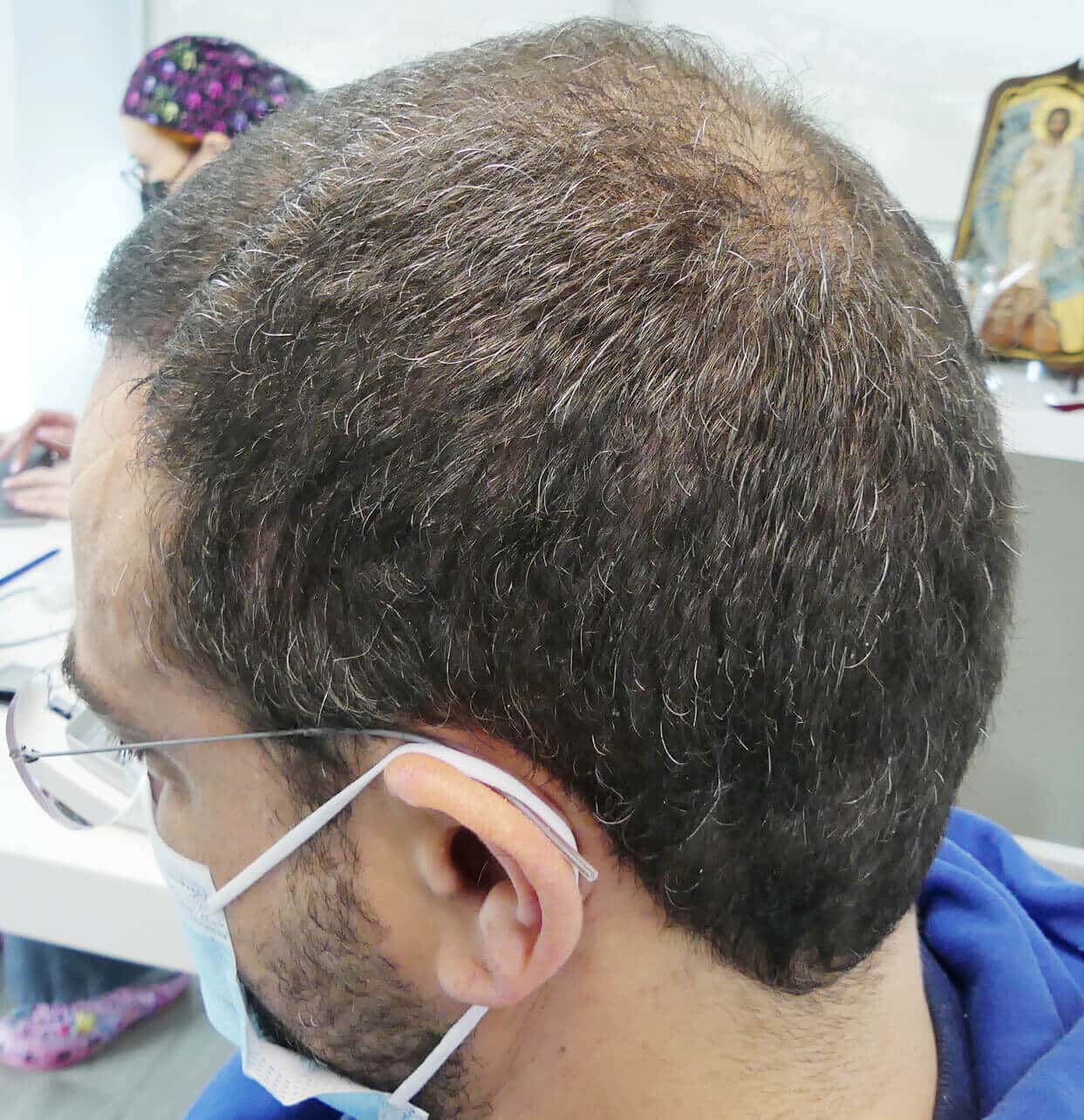
We now proceed with the next procedure, aimed at restoring density to the midscalp and crown, particularly the vertex. This time, we estimated that 2,200 grafts would be sufficient, and an additional 120 grafts were placed as a touch-up on the hairline for further refinement. (Fig. 21a–h)








Once again, the donor area was shaved to allow for precise measurements, ensuring that the dense and even appearance across the scalp would be preserved. Indeed, the condition of the shaved donor area appears outstanding, despite the extraction of 3,000 grafts just four months earlier (Fig. 22a–d). Measurements confirmed that there were still nearly 10,000 grafts available for safe harvesting, without compromising aesthetic density (Fig. 23).



Once again, the procedure was performed over two consecutive days, as harvesting the grafts was now technically more challenging and required greater precision. The final appearance of both the donor and recipient areas post-surgery is visible in Fig. 21f–h, while just one month later—even after a total of 9,000 grafts had been extracted—the donor area still appears healthy and scar-free! (See Fig. 24)






What I Learned from My Experience
The journey of restoring my hair image has been a series of profound lessons. Everything I learned—firsthand, on my own scalp—I’ve applied meticulously so that the mistakes made in my own case now belong to the past. My patients now benefit 100% from that personal experience, ensuring their results are dense, pain-free, scar-free, and successful from the very first procedure, as well as in any future sessions they may need.
At Anastasakis Hair Clinic, we have perfected every detail of the FUE Hair Transplant technique. And that’s precisely because I, myself, have personally experienced the consequences of poor execution of the FUE method. This is what drives my unwavering commitment: To ensure that my patients enjoy only the benefits of a flawless FUE Hair Transplant—in my hands.











